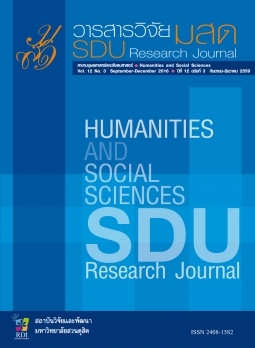การพัฒนาเครื่องมือประเมินผลการเรียนรู้ด้านทักษะการคิดและ การแก้ปัญหาแบบองค์รวมของหมวดวิชาการศึกษาทั่วไป: สคริปต์คอนคอร์แดนซ์ สำหรับนิสิตนักศึกษาระดับอุดมศึกษา
Keywords:
Script Concordance Test, Thinking Skill, Problem Solving, General Education CoursesAbstract
Holistic thinking and problem solving rely on thinking ability, analysis skills and
critical decision making in order to deal with problems. In some situations, problems are
interconnected with other problems which impairs resolution. As a result of this,
assessment tools such as multiple choice questions or self-assessment might not be the
optimal tools for the assessment process. Therefore, the research objective was to
develop and evaluate the quality of the assessment techniques for holistic thinking skills
and problem by using the Script Concordance Test (SCT). The test was developed in its
structure and composition according to an interview with 11 experts in the academic field.
The developed assessment was the situational measurement with 4 items applying a
5-point rating scale included with the SCT. The quality of assessment was tested with the
100 undergraduate students from several faculties at Chulalongkorn University. The test
revealed that IOC = 0.80 – 1.00, inter – rater reliability gave a correlation coefficient in r(18)
= 0.69 - 0.94, p < 0.01, and construct validity of the model was in accordance with the
empirical data, with Chi-square = 12.59, df = 6, p = 0.05, RMSEA = 0.15, CFI = 0.76,
TLI = 0.76, SRMR = 0.17 The quality evaluation process indicated that the developed
assessment technique was high quality and appropriate to evaluate the ability of the
students in thinking and problem solving processes.
References
มลฑา เมืองทรัพย์. (2559). ความพึงพอใจของนักศึกษาต่อการจัดการเรียนการสอนหมวดวิชาศึกษาทั่วไป
ของมหาวิทยาลัยกรุงเทพ. วารสารวิจัย มสด สาขามนุษยศาสตร์และสังคมศาสตร์, 12(2),
127-142.
วรงค์ ถาวระ และคณะ. (2556). กรอบแนวคิดหมวดวิชาศึกษาทั่วไปที่สอดคล้องตามกรอบมาตรฐานคุณวุฒิ
ระดับอุดมศึกษาแห่งชาติ พ.ศ. 2552 (TQF : HEd). สืบค้น 7 พฤศจิกายน 2558, จาก
http://regis.skru.ac.th/RegisWeb/webpage/GE-Network/genbook3.pdf.
ศรีเพ็ญ ศุภพิทยากุล. (2555). การสำรวจสถานภาพและความต้องการการสนับสนุนงานการศึกษาทั่วไปของ
สถาบันอุมศึกษาในประเทศไทย. วารสารการศึกษาทั่วไปแห่งประเทศไทย, 3(2), 66-85.
สุทธิศานติ์ ชุ่มวิจารณ์, สุวิมล ว่องวาณิช และชยุตม์ ภิรมย์สมบัติ. (2559). การพัฒนาและตรวจสอบ
คุณภาพเครื่องมือวัดความยึดมั่นผูกพันการวิจัยของนักศึกษาระดับดุษฎีบัณฑิตคณะครุศาสตร์/
ศึกษาศาสตร์: การวิเคราะห์ด้วยภาวะน่าจะป็นสูงสุดและเบส์. วารสารวิจัย มสด สาขามนุษยศาสตร์
และสังคมศาสตร์, 12(2), 83-107.
อัญชุลี ศิริประพนธ์โรจน์ และชยุตม์ ภิรมย์สมบัติ. (2558). การพัฒนาเครื่องมือประเมินความสามารถ
ในการให้เหตุผลเชิงกรณีของนิสิตนักศึกษาครูโดยใช้เอ็มอีคิวและสคริปต์คอนคอร์แดนซ์. วารสาร
อิเล็กทรอนิกส์ทางการศึกษา, 10(4), 253-267.
Bland, A. C., Kreiter, C. D. & Gordon, J. A. (2005). The Psychometric Properties Of Five
Scoring Methods Applied To The Script Concordance Test. Academic Medicine,
80(4), 395-399.
Brookhart, S. M. (2010). How to Assess Higher-Order Thinking Skills In Your Classroom.
Alexandria: ASCD.
Carrière, B., Gagnon, R., Charlin, B., Downing, S. & Bordage, G. (2009). Assessing Clinical
Reasoning in Pediatric Emergency Medicine: Validity Evidence for a Script
Concordance Test. Annals of Emergency Medicine, 53(5), 647-652.
Charlin, B. & Van Der Vleuten, C. (2004). Standardized Assessment of Reasoning in Contexts
of Uncertainty the Script Concordance Approach. Evaluation & the Health
Professions, 27(3), 304-319.
Gagnon, R., Charlin, B., Coletti, M., Sauvé, E. & Van der Vleuten, C. (2005). Assessment in
The Context of Uncertainty: How Many Members are Needed on The Panel of
Reference of A Script Concordance Test?. Medical Education, 39(3), 284-291.
Garg, D. & Garg, A. K. (2007). General Education Courses at the University of Botswana:
Application of the Theory of Reasoned Action in Measuring Course Outcomes.
The Journal of General Education, 56(3), 252-277.
Hersh, R. H., Bundick, M., Keeling, R., Keyes, C., Kurpius, A., Shavelson, R., Silverman, D. &
Swaner, L. (2009). A Well-Rounded Education for a Flat World. Educational
Leadership, 67(1), 50-53.
Humbert, A. J., Johnson, M. T., Miech, E., Friedberg, F., Grackin, J. A. & Seidman, P. A. (2011).
Assessment of Clinical Reasoning: A Script Concordance Test Designed for
Pre-Clinical Medical Students. Medical Teacher, 33(6), 472-477.
Joe, J. N., Harmes, J. C. & Barry, C. L. (2008). Arts and Humanities General Education
Assessment: A Qualitative Approach to Developing Program Objectives.
The Journal of General Education, 57(3), 131-151.
Laird, T. F. N., Niskode-Dossett, A. S. & Kuh, G. D. (2009). What General Education Courses
Contribute to Essential Learning Outcomes. The Journal of General Education,
58(2), 65-84.
Lubarsky, S., Charlin, B., Cook, D. A., Chalk, C. & Van Der Vleuten, C. P. (2011). Script
Concordance Testing: A Review of Published Validity Evidence. Medical
Education, 45(4), 329-338.
Soper, D.S. (2016). A-priori Sample Size Calculator for Structural Equation Models
[Software]. Retrieved June 22, 2016, from http://www.danielsoper.com/statcalc.
Svanström, M., Lozano-García, F. J. & Rowe, D. (2008). Learning Outcomes for Sustainable
Development in Higher Education. International Journal of Sustainability in
Higher Education, 9(3), 339-351.
Thomas, I. (2009). Critical Thinking, Transformative Learning, Sustainable Education, and
Problem-Based Learning in Universities. Journal of Transformative Education,
7(3), 245-264.
Tsai, T. C., Chen, D. F. & Lei, S. M. (2012). The Ethics Script Concordance Test in Assessing
Ethical Reasoning. Medical Education, 46(5), 527-527.
Translated Thai References
Chumwichan, S., Wongwanich, S. & Piromsormbat, C. (2016). Development and Validation
of the Research Engagement Measurement Instrument for Doctoral Students in
the Faculty of Education: Maximum Likelihood and Bayesian Approaches.
SDU Research Journal Humanities and Social Sciences, 12(2), 83-107. (in Thai)
Muangsub, M. (2016). Students’satisfaction towards Bangkok University General Education
Programs, SDU Research Journal Humanities and Social Sciences, 12(2), 127-142.
(in Thai)
Pasiphol, S. (2013). Measurement and Evaluation in education. Bangkok: Printing
Chulalongkorn University. (in Thai)
Siripraponroch, A. & Piromsombat, C. (2015). A Development of Case-Based Reasoning
Assessment Tool for Student Teachers Using MEQ and Script Concordance.
An Online Journal of Education, 10(4), 253-267. (in Thai)
Supapidhayakul, S. (2011). The Survey Status and Needs for the Support General Education
Courses in the University in Thailand. The journal of General Education Thailand,
3(2), 66-85. (in Thai)
Thavara, V., Runchang, S., siriwong, P., Apanutat, P., Hadtasak, M., Puangnak, P., Artistang, A.,
Vasutapitak, P. & Suankratay, S. (2013). The General Education Framework
According to the National Qualifications Framework for Higher Education.
Retrieved November 7, 2015, from http://regis.skru.ac.th/RegisWeb/webpage/
GE-Network/genbook3.pdf. (in Thai)








